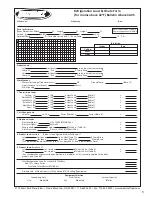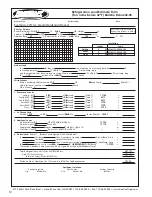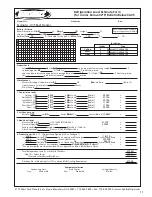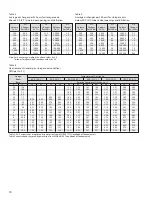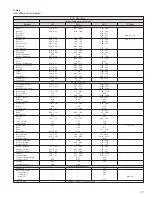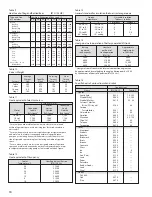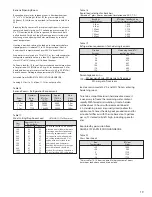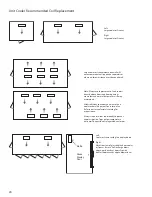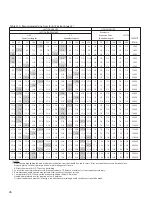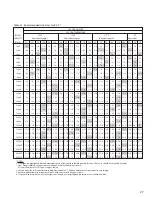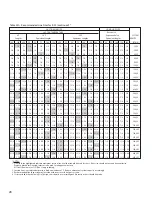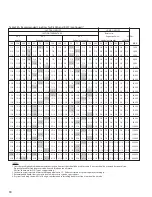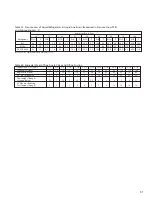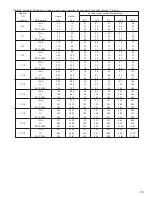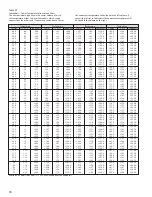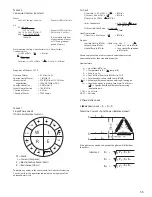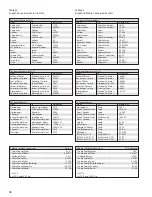
22
Holding freezer
40
80
Packaged Holding center
40
80
Cutting Room
20
30
Meat Chill Room
80
120
Boxed Banana Ripening
120
200
Vegetables and Fruit Storage
30
60
Blast Freezer
150
300
Work Areas
20
30
Unpackaged Meat Storage
30
60
Recommended Number
of Air Changes
Type of Application
Minimum
Maximum
-1,000
31.02
15.27
.0778
1.04
1.03
1.005
-500
30.47
14.97
.0763
1.02
1.02
1.002
0
29.92
14.70
.0749
1.00
1.00
1.00
500
29.38
14.43
.0735
0.98
0.98
0.995
1,000
28.86
14.28
.0719
0.96
0.96
0.998
2,000
27.82
13.67
.0697
0.93
0.93
0.985
3,000
26.81
13.27
.0671
0.90
0.90
0.98
4,000
25.84
12.70
.0647
0.86
0.875
0.975
5,000
24.89
12.23
.0623
0.83
0.85
0.969
6,000
23.98
11.78
.0600
0.80
0.82
0.960
7,000
23.09
11.34
.0578
0.77
0.79
0.955
8,000
22.22
10.92
.0556
0.74
0.76
0.946
9,000
21.38
10.50
.0535
0.71
0.73
0.939
10,000
20.58
10.11
.0515
0.69
0.71
0.93
12,000
19.03
9.35
.0477
0.64
0.66
0.91
14,000
17.57
8.63
.0439
0.59
0.61
0.88
Altitude
Absolute
Pressure
Standard
Capacity
Feet
Air
Multipliers
Above
Density
Air Direct Drive Fans
Sea
At 70ºF.
Dens.
Refrig.
Air Cooled
Level
In. Hg.
PSIA
lbs./Cu.Ft.
Ratio
Evap.
Cond. Unit
4. Type of Operation/Air Flow
Two important considerations in the selection and location of the
unit cooler are uniform air distribution and air velocities which are
compatible with the particular application.
The direction of the air and air throw should be such that there
is movement of air where there is a heat gain; this applies to the
room walls and ceiling as well as the product. The unit cooler(s)
should be arranged to direct its discharge air at any doors or
openings, if it all possible. Avoid placing the unit cooler in a
position close to a door where it may induce additional infiltration
in to the room; this can cause fan icing and a condition known as
hoar-frost. Also, avoid placing a unit in the air stream of another
unit, because defrosting difficulties can result.
For general storage coolers and holding freezers, there are not
criteria for air velocities within the room. The total supply of air
is such that approximately 40 to 80 air changes occur each hour.
This is an air conditioning term which is calculated as follows:
Air Changes = (total cfm*) x 60
internal room volume
* includes all unit coolers and auxiliary fans
This equation disregards the air motion which is induced by the
discharge air from the unit cooler. For simplicity, the gross volume
of the room is used unless the product and equipment occupy
more than 10% of the volume. Specific applications such as
cutting rooms and banana ripening rooms have desired limits. The
table below indicates the minimum and maximum quantities of air
for particular applications.
Derating Factors
A. Ambient
B. Altitude
C. Saturated Suction Temperature (S.S.T.)
D. 50 Cycle Power
In the selection of refrigeration equipment it should be noted
that the manufacturer’s equipment has ratings based on certain
criteria. Care should be taken to determine actual job conditions
and the proper derating factors should be applied. These factors
may vary by manufacturer but can be used here as rule of thumb
approximation.
A. Ambient
Condensing unit ambient is of concern as most equipment is
generally cataloged as 90º to 95ºF. ambient.
Decrease condensing unit capacity 6% for each 10ºF. increase
in operating ambient.
Increase condensing unit capacity 6% for each 10ºF. decrease
in operating ambient.
Recommended Air Changes/Hour
B. Altitude
Most manufacturers rate their equipment at sea level conditions.
An increase in altitude results in a decrease in air density. While
the fans on direct drive equipment will deliver a constant cubic
feet per minute of air regardless of density, the thinness of the
air will affect capacity performance. Belt drive equipment can be
speeded up to compensate for the decrease in air density.
C. Suction Temperature
Care should be taken in the selection of unit coolers, especially
freezer models. There is no set rating standard adopted by the
industry for the ratings criteria. The model number of a low
temperature unit cooler can be rated at -30º SST, -20º SST, -10º
SST, 0º SST, or even +10º SST. The capacity difference between
the -30º SST and the +10º SST can be as much as 15% higher for
the lower rated unit cooler. Most manufacturers provide a suction
temperature correction factor for their unit coolers and this
should be noted in equipment selections.
D. 50 Cycle Power
Since we live in a “global village,” the opportunity to quote
refrigeration equipment for export markets is one not to be
ignored. Motors that are sized for 60 cycle operation run at 83%
(50/60) speed on 50 cycles operation. Compressors produce only
5/6 of their capacity. However, while fans are only running 83%
speed, there is also a decrease in static pressure through the
condenser or unit cooler coil and performance does not suffer the
full 17% penalty. If it has been verified by the manufacturer that
their equipment can be run on 50 cycle power then the following
derating factors can be applied:
A.
Unit coolers and air-cooled condensers (Capacity x 0.92)
B.
Air-cooled condensing units (capacity x .85)
System capacity (unit cooler and air-cooled condensing unit) can
be derated by 0.88
To select refrigeration equipment after the load has been
determined, divide the BTUH required by (0.88):
BTUH = Conversion to select 60 cycle
0.88 equipment for 50 cycle load
This provides for larger equipment necessary to compensate for
50 cycle derating factor.
Effects of Altitude on Air Cooled Equipment


